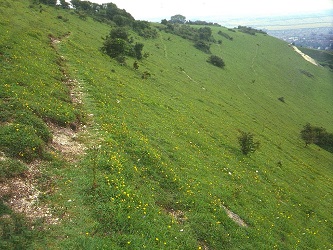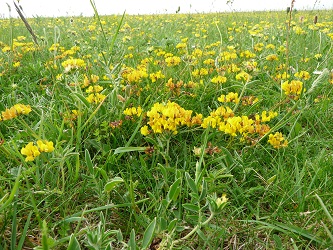Current ISIS code: F112
Previous assemblage name: F213 lowland short sward calcareous grassland.
Linked assemblage: F111 bare sand & chalk.
It is possible that this assemblage may possess sub-communities which could be recognised on the basis of key larval food plants which might only occur in particular habitat expressions of this assemblage.
Description of habitat typically supporting the assemblage: This Specific Assemblage Type is supported by multivariate analysis of samples of several groups taken in 2007. It is separated from F111 assemblages and F2 assemblages along the main axis of variation produced by detrended correspondence analysis. The dependency of F112 species on warm, dry soil conditions is less extreme than that of F111 species.

F112 assemblages occur in poached short sward grassland, especially calcareous grassland, but not in uniform, dense sward grassland where moist conditions prevail at ground level. It is therefore dependent on natural or anthropogenic disturbance, especially grazing, and is likely to be responsive to climate change.
The assemblage type is found most frequently in lowland habitats where grazing or cutting of vegetation over calcareous soils limits the development of taller vegetation. Soils are also generally nutrient poor, which limits the dominance of grasses and thereby encourages widespread development of broad-leaved herbs.

Exposure may also be a key factor in limiting taller growth on coastal sites. Taller vegetation and even woody plants are nonetheless often an important component of the overall habitat. The balance between taller and coarser vegetation and the factors which limit it is often a fine one and sites may undergo cycles of changing proportions of open short sward grassland and taller growth as a result.
This is especially the case where human intervention is required to maintain open short sward conditions. Consequently, land use and its underlying economic factors have a pervading influence on this dynamic equilibrium.
Chalk downland and limestone grasslands are the predominant semi-natural systems supporting this assemblage type, although elements may also occur on short acid turf, sea cliffs and sand dune systems where shelly wind-blown sand produces similar conditions.

Sampling & assessing the assemblage
Standard sampling protocols apply.
Target groups: Bees & wasps, beetles, larger flies, day-flying butterflies & moths, True “het” bugs, grasshoppers & crickets.
Fieldwork methods: Ground-searching, spot-sweeping, sweeping.
Alternative methods: Pitfall trap grids.
Season: Late April- mid June.
Discrimination of conservation quality: good
Default target: 13 species
